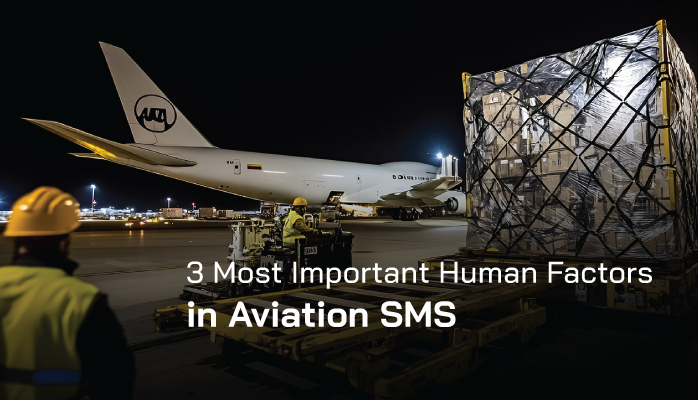Root Human Factors and Symptomatic Human Factors

The Dirty Dozen Human Factors in aviation safety management systems (SMS) are not isolated factors.
They are an interwoven set of human actions that influence each other. And they are not all created equal.
Some Human Factors can pose significant risks but generally appear as symptoms of Human Factors that are more fundamental to human action. In this sense, Human Factors are layered.
Identification of Human Factors in SMS
Identifying important Human Factors in aviation SMS is useful for a couple of reasons. Aviation safety managers and employees alike:
- Can hone in on the thematic root causes of the SMS through Human Factors; and
- Better understand the relationship of Human Factors in aviation SMS.
When it comes to using Human Factors in aviation SMS, such focus and understanding are critical. As I have said before, Human Factors need to be understood as the human potential for risk, but also as the solution for adaptable and proactive risk management.
The bureaucratic processes of aviation SMS should be built up around Human Factors to empower employees rather than “treat the human problem.”
Here are the three thematic and (therefore) most important Human Factors in aviation SMS. They are a recurring and identifiable factor in nearly every Human Factor-related safety concern that safety managers should watch out for and employees should learn to identify in their environment. Here’s why.
Related Aviation Human Factors Articles
- Let’s Talk Human Factors - Origin of Dirty Dozen
- Let’s Talk Human Factors - Lack of Communication
- 5 Things to Know About Aviation SMS Human Factors
1 – Human Factor #5: Lack of Teamwork
I’m guessing many of you probably expected to see Lack of Communication as number one. It is one of the often most touted of The Dirty Dozen. But I would say this: Lack of Communication is almost always a product of an inability to form quality teamwork interactions (i.e. lack of teamwork). Moreover, quality communication is extremely difficult without quality teamwork, and yet quality teamwork is possible with communication barriers (i.e. language).
While there are obvious communication problems, such as with the use of technology, Lack of Communication often gets pinned on situations where two employees “misunderstood” each other because of “a failure to transmit, receive, or provide... information”. Oftentimes, the failure to transmit or receive data is simply a result of individuals not knowing how to properly work together. Good communication is a result of good teamwork and not the other way around.
Moreover, toxic social work environments universally propagate Lack of Assertiveness. Individuals in such environments will often be unwilling to speak up in order to prevent the possible scorn of others or the punishment of superiors.
Finally, considering that employees are the best and most important resource for identifying and reporting hazards, Lack of Teamwork can be a disastrous blow to the resources of aviation SMS. While there are other considerations with the Lack of Resources Human Factor, such as equipment, technology, etc., a team that works well together can accomplish more with limited technology, money, and manpower than a large team with the financial backing and technological resources.
Teamwork is an SMS’ greatest resource for cultivating a safe environment.
2 – Human Factor #8: Pressure

Specifically, the Human Factor of Pressure that is universally common in aviation SMS relates to the pressure of performance vs preparation. Aviation carriers all rely on their services to make money and drive the business. These requisite services usually hinge on time-sensitive and quality actions.
Time and quality create pressures to perform at all levels of an organization. In some (or many) cases, it causes:
- Lack of Awareness: employees may be so focused on completing a task that they fail to notice potential hazards;
- Fatigue: plain and simple, extended periods of pressure will result in both physical and mental exhaustion;
- Distraction: employees may be distracted from following the correct procedures by cutting corners to complete the task; and
- Stress: stress is almost always the result of certain pressures, and can cause risky, irrational behavior.
Pressure has far-reaching implications for the emotional and psychological state of all employees. In organizations that strive to maintain low-pressure environments, employees have more mental energy to be aware, more time to focus, and fewer reasons to be stressed out.
3 – Human Factor #12: Norms
An aviation SMS' existing norms play a critical role in the functioning of the SMS. Norms can be expected duties and responsibilities, the goals of the aviation safety management system, or the behavior of employees and management.
Aviation SMS environment with risky norms almost always results in two things:
- Lack of Knowledge: as employees don’t have the incentive to learn and therefore improve safety behavior;
- Complacency: the bane of every aviation safety management system.
Complacency, like Lack of Communication, is an extremely hot topic in aviation SMS because so many managers struggle with it. Overcoming it has proven time and time again perhaps the most difficult barrier to completing aviation SMS implementation.
Complacency is almost always a direct result of an existing norm. It’s a vicious cycle. An organization is used to having low SMS standards, and as employee and management turnover happens, complacency is simply adopted by new workers. Before managers can overcome complacency in aviation SMS, they must first identify:
- The type of complacency norm that exists; and
- The underlying causes (such as lack of management involvement) or specific leaders in the program who are propagating the complacency.
Related Aviation Human Factors Articles
- The 13th Aviation SMS Human Factor -- Adopting Risk Attitude
- How Human Factors in Aviation SMS Should Be Viewed
- More Than Dirty: Advanced Use of Human Factors in Aviation SMS
Final Thought: Human Factor Identification Is Unique
While I have argued that Human Factors have layers and that there ARE more important Human Factors in aviation SMS, identifying the specific behaviors, attitudes, and symptoms will be different in each SMS.
What looks like a Lack of Teamwork in one company may actually be a result of Pressure in another. Recognizing the most thematic Human Factor in your SMS involves identifying your environment's specific needs.
Last updated in April 2025.





